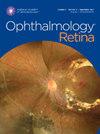Assessment of Proliferative Vitreoretinopathy in Rhegmatogenous Retinal Detachment with OCT
IF 5.7
Q1 OPHTHALMOLOGY
引用次数: 0
Abstract
Purpose
To characterize proliferative vitreoretinopathy (PVR) with swept-source OCT (SS-OCT) in rhegmatogenous retinal detachment (RRD).
Design
Prospective cross sectional cohort study.
Subjects
Consecutive primary RRDs presenting to St. Michael’s Hospital from 2021 to 2023.
Methods
Ultra-widefield fundus imaging was staged per the Retina Society 1991 PVR Classification and correlated with retinal microstructural changes assessed with SS-OCT.
Main Outcome Measures
Swept-source OCT findings in PVR.
Results
One hundred patients were included. Patients with no signs of PVR or PVR A (49/100) were more likely to have a preserved bacillary layer on SS-OCT with low-amplitude outer retinal corrugations (ORCs) compared with the PVR B/C group. Proliferative vitreoretinopathy B (retinal wrinkling/vessel tortuosity) was present in 24% (24/100) of cases, all of which had high-amplitude ORCs. Proliferative vitreoretinopathy C (27/100) was clinically divided into patients with subretinal (SR) membranes (63% [17/27]) and patients with fixed retinal folds (intraretinal [IR]) (37% [10/27]). The SR subtype was associated with slowly progressive detachments. On SS-OCT, they had a thick hyperreflective membrane emanating from the retinal pigment epithelium and extending along the outer retinal surface, causing tractional folds of the outer retina in 47% (8/17) of cases and tractional bacillary layer detachment in 12% (2/17) of cases. Outer retinal thinning/atrophy was commonly observed in the SR subtype. Patients with the IR subtype had rapidly progressive detachments on fundus examination and extensive IR changes on SS-OCT. These had a thickened bacillary layer with high-amplitude ORCs with photoreceptor-photoreceptor apposition within or between individual corrugations (fused ORCs). Significant preretinal membranes with loss of differentiation of the inner and outer retinal lamellae and distortion of underlying ORCs were observed.
Conclusions
Our study demonstrates imaging evidence of varying PVR morphology. The IR subtype occurs in rapidly progressive detachments with intrinsic retinal changes that span from fused and distorted corrugations to retinal thickening, preretinal membranes, and loss of differentiation of retinal lamella. The SR subtype occurs in slowly progressive detachments, where the proliferation is associated with membranes emanating from the retinal pigment epithelium, outer retinal thinning/atrophy, and tractional outer retinal folds. We present a novel OCT classification of primary PVR, which varies based on RRD morphology. Pathological photoreceptor apposition in fused ORCs may be associated with glial proliferation and corresponding IR and preretinal changes.
Financial Disclosure(s)
Proprietary or commercial disclosure may be found in the Footnotes and Disclosures at the end of this article.
利用OCT评估孔源性视网膜脱离的增生性玻璃体视网膜病变:重述1991年视网膜学会分类。
目的:应用扫描源光学相干断层扫描(SS-OCT)研究孔源性视网膜脱离(RRD)的增生性玻璃体视网膜病变(PVR)。设计:前瞻性横断面队列研究。研究对象:从2021年到2023年在圣迈克尔医院就诊的连续原发性rrd患者。方法:超宽视场(UWF)眼底成像按照视网膜学会1991年PVR分级分级,并与SS-OCT评价的视网膜显微结构变化相关联。主要观察指标:PVR的SS-OCT表现。结果:纳入100例患者。与PVR B/C组相比,无PVR或PVR A症状的患者(49/100)在SS-OCT上更有可能保留有低幅度视网膜外波纹(ORCs)的细菌层。24%(24/100)的病例存在PVR B(视网膜起皱/血管扭曲),均为高振幅ORCs。PVR C(27/100)临床分为视网膜下膜(SR)患者[63%(17/27)]和视网膜固定皱襞(IR)患者[37%(10/27)]。SR亚型与浅的、缓慢进展的分离相关。在SS-OCT上,他们有一层厚的高反射膜从视网膜色素上皮发出并沿着视网膜外表面延伸,导致47%(8/17)的病例外视网膜牵引皱褶和12%(2/17)的病例牵引菌层脱离。外视网膜变薄/萎缩常见于SR亚型。IR亚型患者眼底检查有大泡性脱离,SS-OCT检查有广泛的视网膜内改变。这些有增厚的细菌层,具有高振幅的ORCs,在单个波纹内或之间有光感受器-光感受器重合(融合ORCs)。观察到明显的视网膜前膜,内层和外层视网膜片的分化丧失和底层ORCs的畸变。结论:我们的研究提供了不同PVR形态的影像学证据。IR亚型发生在大泡性脱离,伴有视网膜固有的变化,从融合和扭曲的波纹到视网膜增厚、视网膜前膜和视网膜片层分化丧失。SR亚型发生在浅的,缓慢进展的脱离,其中增殖与RPE发出的膜,视网膜外变薄/萎缩和牵拉性视网膜外折叠有关。我们提出了一种新的基于RRD形态的原发性PVR OCT分类方法。ORCs的病理性视网膜内病变可能导致胶质细胞增殖和随后的视网膜内和视网膜前改变。
本文章由计算机程序翻译,如有差异,请以英文原文为准。
求助全文
约1分钟内获得全文
求助全文

 求助内容:
求助内容: 应助结果提醒方式:
应助结果提醒方式:


